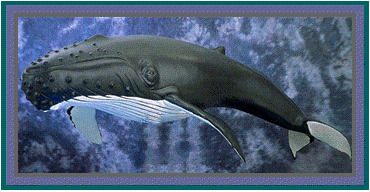




 are whale. Although they spend their lives in the sea, whales are not Fish. They are warm-blooded mammals. The young whale is born alive and fed by its mother's milk, like the young of land mammals.
are whale. Although they spend their lives in the sea, whales are not Fish. They are warm-blooded mammals. The young whale is born alive and fed by its mother's milk, like the young of land mammals.

 The front limbs are modified into a pair of flippers and are used primarily as stabilizers or steerin mechanisms. The front limb's bone have the same bones as human arms but are shortened. The fingers have been greatly lengthened and enclosed in mittens of flesh, which make the flippers.
The front limbs are modified into a pair of flippers and are used primarily as stabilizers or steerin mechanisms. The front limb's bone have the same bones as human arms but are shortened. The fingers have been greatly lengthened and enclosed in mittens of flesh, which make the flippers.
 The hind limbs are represented only by a few bony vestiges.
The hind limbs are represented only by a few bony vestiges.
 A dorsal fin is usually present, and the tail fin consists of a pair of horizontal flukes.
A dorsal fin is usually present, and the tail fin consists of a pair of horizontal flukes.
 The primary thrust in locomotion is derived from up-and-down movements or the tail and flukes.
The primary thrust in locomotion is derived from up-and-down movements or the tail and flukes.

 The low pitch signals, such as Whistles, bark, screams,Cry, and moans are audible to humans, are used in social communication.
The low pitch signals, such as Whistles, bark, screams,Cry, and moans are audible to humans, are used in social communication.
 The brief clicks of high intensity sound, some about 13 times the upper audible frequency of humans, are used to navigate or to identify food sources
The brief clicks of high intensity sound, some about 13 times the upper audible frequency of humans, are used to navigate or to identify food sources

 Baleen Whales: Finback Whale, Minke Whale, Humpback Whale, Right Whale, Gray Whale, Blue Whale, and Sei Whale.
Baleen Whales: Finback Whale, Minke Whale, Humpback Whale, Right Whale, Gray Whale, Blue Whale, and Sei Whale.
 Toothed Whales: Pilot Whale, Bottlenose Dolphin.
Killer Whale, Sperm Whale, Narwhal
Toothed Whales: Pilot Whale, Bottlenose Dolphin.
Killer Whale, Sperm Whale, Narwhal

 Baleen whales are plankton feeder. Their diet consists of a variety of small Crustaceans called copepods, krills and other small creature.
Baleen whales are plankton feeder. Their diet consists of a variety of small Crustaceans called copepods, krills and other small creature.
 The toothed whale are all predators, feeding actively on fish and Squid.
The toothed whale are all predators, feeding actively on fish and Squid.



 Minke Whale
Minke Whale
 Killer Whale
Killer Whale
 Gray Whale
Gray Whale
 Humpback Whale
Humpback Whale
 Humpback Whale
Humpback Whale



 For more information; please click the following:
For more information; please click the following: Sea World
Sea World
 The WWW Virtual Library
The WWW Virtual Library
 Books (Login as Library)
Books (Login as Library) Articles
Articles
 Omni Web
Omni Web
 Contact Us
Contact UsIf you are an educator who is using our NEXTSTEP or virtual applications in the classroom, we would especially like to hear from you. Let us know what you are doing and how it is working out. Continued support for this project will depend on its impact in science education.
If you are an educator who is interested in making use of our NEXTSTEP or virtual applications, please let us know how we can help.
 Return to the Electronic Desktop Project home page
Return to the Electronic Desktop Project home page
![]() Check out the WWW Virtual Application Catalog from the EDP
Check out the WWW Virtual Application Catalog from the EDP
 Check out the NEXTSTEP Application Catalog from the EDP
Check out the NEXTSTEP Application Catalog from the EDP
 Visit the home page for California State University, Los Angeles
Visit the home page for California State University, Los Angeles